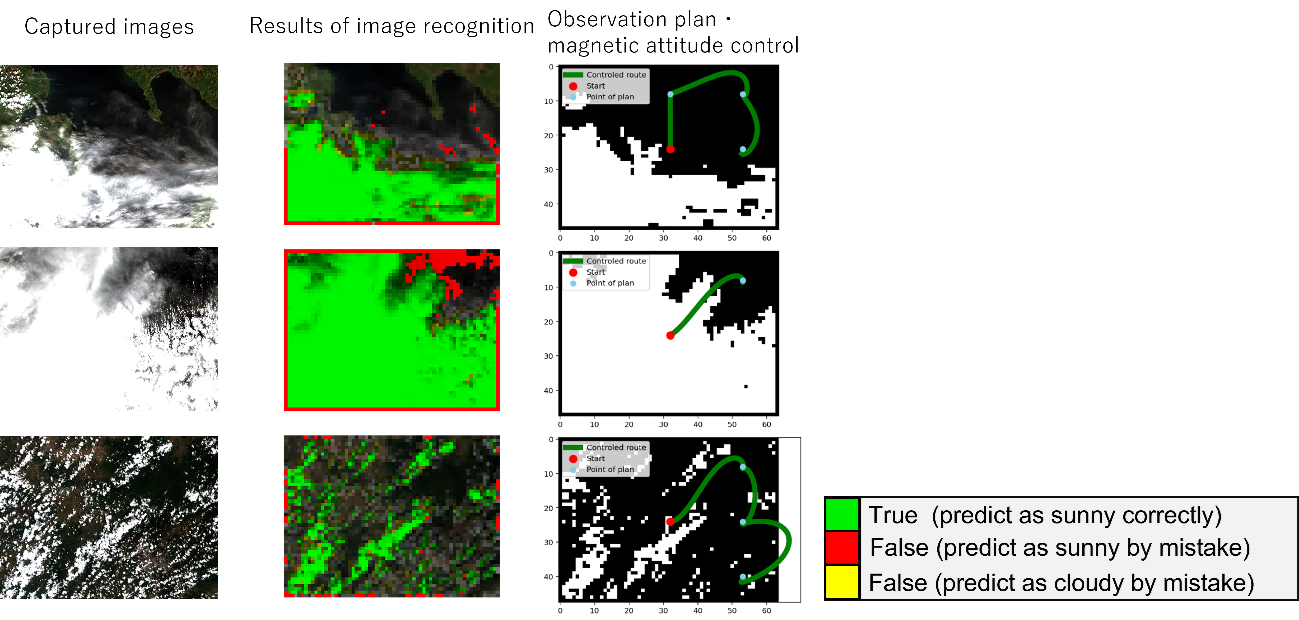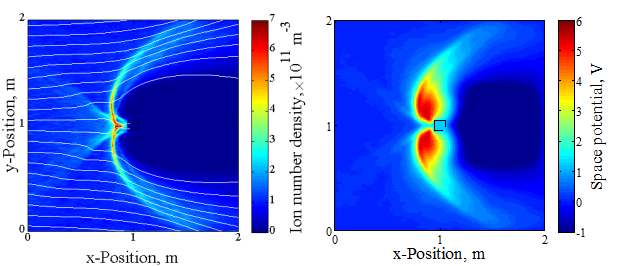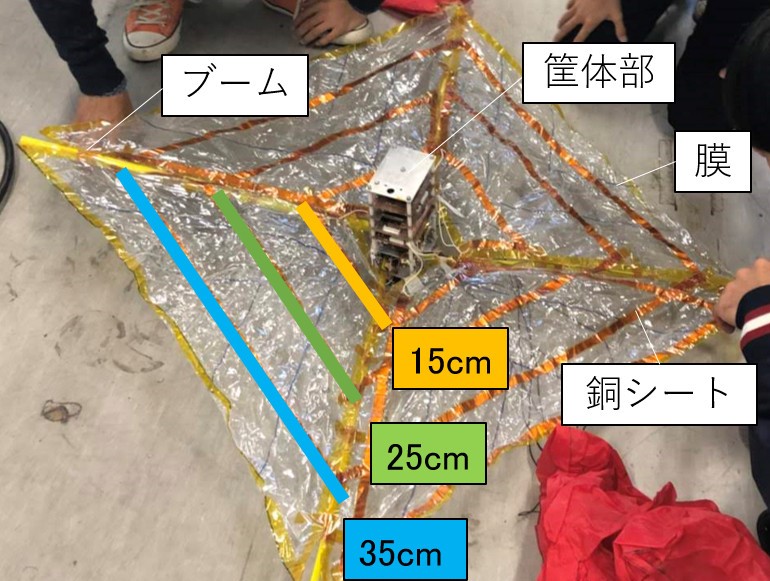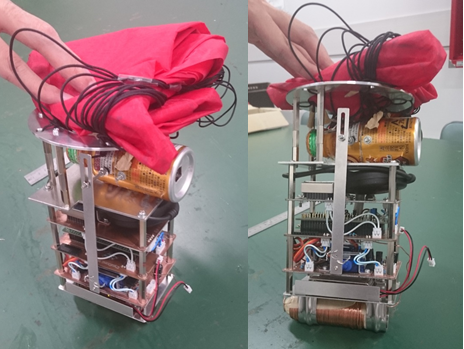Overview of our laboratory
Space system can be achieved only by small satellites.
To take advantage of small sized space systems, these systems should acquire unique abilities by focusing on phenomena which are more effective for smaller satellites. Additional advantages can be gained by the additional use of various resources and other things found in its orbital environment. Our research group recognizes that a smaller sized satellite is more affected by its environment. Additionally, it considers the use of these environments, to achieve higher performance with smaller system resources to be useful. Furthermore, space applications with these high performance bus systems are studied, by taking advantage of the unique abilities of these small spacecraft.
Attitude control maneuver using interplanetary magnetic field
Attitude orbit and control system by the use of space environment.
In our research, we continue to expand the abilities and applications of small spacecraft,
while considering the space environments that more easily affect smaller sized spacecraft,
specifically environmental outer magnetic fields and space plasma. We focus on attitude and orbit
determination and control for small spacecraft to expand the abilities and applications. Except for attitude
orbit control systems, our interest lies on C&DH, thermal, communication, space system designs, and their applications.
We also try to find chances for in-orbit demonstrations for the benefit of proposing space systems.
1. Research topics
Space Systems
Magnetic Docking System
Making application of multiple small sized satellite easier
In recent year, docking of satellite has been pointed out as an important technology in using multiple small satellite as one system. In order to allow small sized satellite which heavy weight and space restriction to perform docking, we are study the use of simple magnets or magnetized objects to see whether if guiding, keeping combination and separation can be perform using only one component. We hope to make mission with multiple spacecraft easier to accomplished.

Efficient Remote Sensing through Autonomous Image Recognition
Satellite remote sensing is widely used for various purposes such as land management, forest management, water resource management, and food security. In such a situation, efficient remote sensing for obtaining information over large areas while avoiding obstacles like clouds are necessary. This research aims to achieve efficient remote sensing through autonomous image recognition, recognizing the clouds. For cloud detection, this research utilizes a Convolutional Neural Network (CNN) to detect clouds that hinder observation, instead of directly detecting the observation targets. This approach helps reduce the algorithm's complexity, making it feasible to implement on satellite onboard computers with limited processing capabilities. The information of the cloud detection results are used for attitude control by applying the magnetic moment generated by a magnetic actuator in the geomagnetic field. The algorithm was implemented on a small satellite, and preparations for in-orbit demonstration. This research was supported by the Japan Keirin Autorace foundation (JKA) in the fiscal year 2022.


A novel attitude control method for space membrane using space environmental force
Space membrane deployment/attitude control using electromagnetic force
We are researching for a novel method to deploy/attitude control space membrane using electromagnetic force. In our proposed method, first, copper film is placed on membrane. Then, using hoop stress and Lorentz force generated from interaction with magnetic field in space environment, deployment and attitude control of membrane is performed. By changing the current flow in copper film, deployment force and control force strength can be changed. Currently, we are researching to see whether if this method allow easier control of the vibration during deployment or restoring of membrane as well as whether if it can be used as fuel free attitude changing method.

Attitude control of Spacecraft
Attitude control maneuver using interplanetary magnetic field
In recent year, the use of smaller space probe has been proposed and researched on. In our research, we study methods to perform attitude and/or angular momentum control using interplanetary magnetic field and its interaction with magnetic moment of space probe.

Magnetic torque born from shape anisotropy
To make clear the magnetic forces acting on small-sized satellite
In the case of small-sized satellite, which has small moment of inertial, magnetic torques and various other environmental torques can have heavy effect on its attitude dynamics. In this research, we focus on the magnetic torque born from the shape anisotropy of magnetic moment of components within small-sized satellite. This torque is generated from the interaction of geomagnetic field and magnetic moment which get larger the more asymmetric these components are. Just like magnetic torque generated by remnant magnetic moment, which has been deeply researched, we found that magnetic torque generated from shape anisotropy of magnetic moment of component is also large and can heavily effect the accuracy of attitude control. By making clear how magnetic torque generated from shape anisotropy, we hope to increase the accuracy of attitude determination and control.

Orbit control of Spacecraft
Deorbit using magnetic plasma
Applying magnetic torquer of attitude control system into orbit control
In order to reduce the increasing amount of space debris, an international rule where every satellite must deorbit (return to earth’s atmosphere) within 25 years after the end of the missions has been made. Even small-sized satellites, which has been increasing in demand in the recent years, are also not exempted from this rule. However, due to their heavy restriction in size, weight and power consumption, small-sized satellites is incapable of performing orbit control, making it a problem for them to obey the 25 years deorbit rule. In order to overcome this problem, a method that make used of the components that are already loaded within the satellite, “Magnetic plasma deorbit by using magnetic torquer of attitude control system” was proposed. In this method, drag force is generated by using the interaction between magnetic torquer, which is commonly used in small-sized satellites attitude control, and space plasma, which exists at low earth orbit. In this research, we study on how much this magnetic plasma deorbit method can change the small-sized satellite orbit and whether if we can reduce the deorbiting time if the output of magnetic torquer is controlled. Furthermore, research is also being done to see if this method is applicable to perform and maintain formation fly of small-sized satellite.


2. CanSat
As a preliminary practice for actual satellite development, we develop a can-size imitation (Cansat) that contains basic functions of actual satellite. In 2018, in relation to one of our research topics “attitude control of space membrane using electromagnetic force”, we developed and launched a Cansat that has membrane’s deployment structure as well as a circuit that allows large electric current flow on top of the satellite’s membrane. The developed Cansat was launched at ARLISS, an annual event at Black Rock desert in Nevada State, America where many teams around the world gather together and launch their Cansat.


3. Publications
2022
International conferences
H. Tamura, J. Park, T. Inamori, R. Hamaguchi, K. Otsuki, “Data-Driven FDI Focusing on the Attitude Dynamics of Spacecraft”, The 73rd International Astronautical Congress, IAC-22-D1.2.1, Paris, France, 2022.T. Inamori, J. Park, K. Nagai, H. Tamura, G. Xinbo, Y. Fujita, R. Yamaguchi, T. Miyamoto, D. Ukita, T. Osaki, Y. Sakaguchi, N. Tamaoki, Y. Yasuda, “In-Orbit Demonstration of Propellant-Less Formation Flight with Momentum Exchange of Jointed Multiple CubeSats in the MAGNARO Mission”, The 36th Annual Small Satellite Conference, SSC22-WKVII-07, Logan Utha, USA, 2022.
2021
Journal papers
Y. Yamada, T. Inamori, J. H. Park, Y. Satou, Y. Sugawara, and K. Yamaguchi, “Attitude Control of Spin-type Membrane Structures using Electromagnetic Force in Earth Orbit”, Advances in Space Research, in press.International conferences
K. Yamaguchi, X. Gu, T. Inamori, J. Park, “On orbital dynamics of gravity tractor spacecraft exploiting artificial halo orbit”, The 33rd International Symposium on Space Technology and Science, 2022-r-04, online, 2022.T. Inamori, J. Park, Y. Yamada, T. Xuan, X. Gu, K. Nagai, “Propellant-less formation flight with momentum exchange of jointed multiple Cubesats in the MAGNARO mission”, The 33rd International Symposium on Space Technology and Science, 2022-f-36, online, 2022.
T. Osaki, J. Park, T. Inamori, K. Yamaguchi, "Satellite attitude optimization for automatic earth observation with cloud detecting CNN", The 33rd International Symposium on Space Technology and Science, C000235, Online, 2022.
X. Gu, K. Yamaguchi, T. Inamori, "Dynamics and control for near-earth asteroid orbiting spacecraft using solar sails," The 33rd International Symposium on Space Technology and Science, 2022-d-12, online, 2022.
J. Park, T. Inamori, H. Masuda, T. Miyamoto, T. Noro, K. Nagai, K. Kinefuchi, R. Kawashima, K. Yamaguchi, “Magnetic plasma drag demonstration mission for nanosatellite orbit control,” The 33rd International Symposium on Space Technology and Science, 2022-d-12, online, 2022.
J. Park, T. Inamori, T. Osaki, R. Hamaguchi, K. Otsuki, “Space-camera artificial intelligence mission for image data prioritization,” The 33rd International Symposium on Space Technology and Science, 2022-d-12, online, 2022.
2020
Journal papers
K. Yamaguchi, X. Gu, T. Inamori, K. Kimura, Y. Sakurai, "Study on Ballistic Kinetic Impactor Mission Design and Evaluation Using Impact-Geometry Maps", Acta Astronautica, vol. 181, pp. 336-351, 2021.J. Park, T. Inamori, R. Hamaguchi, K. Otsuki, J. Kim, K. Yamaoka, “RGB image prioritization using convolutional neural network on a microprocessor for nanosatellites”, Remote Sensing, vol. 12, no. 23, 2020.
Y. Yamada, T. Inamori, “Propellantless Close Range Guidance for Small Satellites Dockings Using Simple Electromagnetic Devices”, Trans. JSASS Aerospace Tech. Japan, accepted.
K. Yamaoka, H. Tajima, K. Miyata, T. Inamori, Y. Sasai, H. Kawahara, J. Park, K. Nakazawa, S. Masuda, K. Matsushita, K. Itoh, D. Nobashi, H. Takahashi, K. Watanabe, “Solar Neutron Spectrometer Onboard a 3U CubeSat”, Trans. JSASS Aerospace Tech. Japan, accepted.
International conferences
H. AN, T. Inamori, Y. Yamada, J. Park “Demonstration of the Propellant-less Constellation with Jointed Cubesats Separation by Centrifugal Force in the MAGNARO Mission”, 71st International Astronautical Congress, IAC-20,B4,VP,26,x59807, 2020.T. Noro, T. Inamori, J. Park, “Formation Flying under Periodic Orbit Considering Environmental Forces in LEO,” 2021 AIAA SciTech Forum, Online, AIAA 2021-1383, 2021.
2019
Journal papers
T. Inamori, S. Ikari, T. Ito, and R. Kawashima, “Interplanetary magnetic attitude control based on an IMF Kalman filter in small spacecraft,” IEEE Transactions on Aerospace and Electronic Systems, vol. 55, no. 6, pp. 2674-2686, 2019.T. Inamori, P. Saisutjarit, N. Sako, Y. Terao, and S. Nakasuka, “Magnetic attitude disturbance caused by asymmetrical magnetic substances in LEO satellites,” Journal of Aerospace Engineering, vol. 32, no. 6, pp. 1-12, 2019.
International conferences
J. Park, I. Jeung, and T. Inamori, “Telemetry and Two Line Element data analysis for SNUSAT-1b anomaly investigation,” The 32th International Symposium on Space Technology and Science (ISTS), 2019-f-76, Fukui, Japan.Y. Yamada and T. Inamori, "Propellantless Close Range Guidance and Docking for Small Satellites Using Simple Electromagnetic Devices", The 32th International Symposium on Space Technology and Science (ISTS), 2019-d-043, Fukui, Japan.
Y. Yamada, T. Inamori, adn Y. Satou, "A Fuel-free Agile Attitude Maneuver of Space Membrane Structures Using Electromagnetic Force in LEO", The 70th International Astronautical Congress, IAC-19-E2.1.4, Wasington D.C., United States of America, 2019.
K. Miyata, R. Kawashima, T. Inamori, "Aerodynamic Coefficient Identification of Small Satellites", 2019-f-41, 32nd ISTS & 9th NSAT, Fukui, 2019.
K. Yamaoka, H. Tajima, K. Miyata, T. Inamori, Y. Sasai, H. Kawahara, J. Park, K. Nakazawa, S. Masuda, K. Watanabe, "Solar Neutron Spectrometer Onboard a 3U CubeSat", 2019-r-33, 32nd ISTS & 9th NSAT, Fukui, 2019.
K. Yamaoka, H. Tajima, K. Miyata, T. Inamori, Y. Sasai, H. Kawahara, J. Park, D. Nobashi, K. Itoh, K. Matsushita, K. Nakazawa, S. Masuda, H. Takahashi, K. Watanabe, Solar Neutron and Gamma-ray Spectroscopic Mission The 4th COSPAR symposium, Herzliya, Israel, 2019.
K. Yamaoka, H. Tajima, K. Miyata, T. Inamori, Y. Sasai, H. Kawahara, J. Park, K. Nakazawa, S. Masuda, K. Matsushita, K. Itoh, D. Nobashi, H. Takahashi, K. Watanabe, "Solar Neutron and Gamma-ray Spectroscopy (SONGS) Mission", 12th International "Hiroshima" Symposium on the Development and Application of Semiconductor Tracking Detectors (HSTD12), Hiroshima, Japan, 2019.
K. Yamaoka, H. Tajima, K. Miyata, T. Inamori, Y. Sasai, H. Kawahara, J. Park, K. Nakazawa, S. Masuda, K. Matsushita, K. Itoh, D. Nobashi, H. Takahashi, K. Watanabe, "Solar Neutron and Gamma-ray Detector for a 3U CubeSat," 36th International Cosmic Ray Conference -ICRC2019, WI, US, 2019.
2018
Journal papers
J. Park, S. Matsuzawa, T. Inamori, I. Jeung, Nanosatellite constellation deployment using on-board magnetic torquer interaction with space plasma, Advances in space research, Article in press, 2018.X. Yaen, W. Xiande, T. Inamori, S. Zhen, S. Xinzhu, C. Hongtao, "Compensation of base disturbance using optimal trajectory planning of dual-manipulators in a space robot", Advances in space research, Vol. 63, Issue 3, pp. 1147-1160, 2019.
T. Inamori, S. Ikari, T. Ito, R. Kawashima, "Interplanetary magnetic attitude control based on an IMF observer in small Spacecraft", IEEE Transactions on Aerospace and Electronic Systems, article in press.
T. Ito, S. Ikari, R. Funase, S. Sakai, Y. Kawakatsu, A. Tomiki, T. Inamori, "Active use of solar radiation pressure for angular momentum control of the PROCYON micro-spacecraft", Acta Astronautica, Elsevier, Vol. 152, pp 299-309, 2018.
T. Kawai, T. Inamori, K. Hori, "Analytical Lorentz force model between one-dimensional linear currents in arbitrary relative positions and directions", IEEE Transactions on Magnetics, vol. 54, no. 8, pp. 1-16, 2018.
R. Kawashima, S. Matsuzawa, J. Park, T. Inamori, "Particle Simulation of Plasma Drag Force Generation in the Magnetic Plasma Deorbit", Journal of spacecraft and rocket, Vol. 55, No. 5, pp. 1074-1082, 2018.
K. Miyata R. Kawashima, T. Inamori, "Detailed Analysis of Aerodynamic Effect on Small Satellites", Trans. JSASS Aerospace Tech. Japan, Vol.16, No.5, pp.432-440, 2018.
International conferences
Y. Yamada, T. Inamori, M. Tomooka, "Propellantless Close Range Rendezvous and Docking Using a Single Electromagnetic Device for Small Spacecraft", The 69th International Astronautical Congress, IAC-18-E2.2.5, 2018.P. Phlaengsorn, H. Truong An, T. Inamori, P. Saisutjarit, "Fuel free angular momentum unloading using the interplanetary magnetic field in small-sized spacecraft", IAC-18-B4,8,15, The 69th International Aerospace Congress, Bremen, Germany, 2018.
S. Ikari, T. Inamori, T. Ito, R. Funase, "Analysis of disturbance anomaly of interplanetary microspacecraft Procyon", AAS 19-526, 29th AAS/AIAA Space Flight Mechanics Meeting, Ka’anapali, HI, 2018.
T. Inamori, M. Fujiwara, Y. Yamada, S. Matsuzawa, "Fuel-free magnetic rendezvous using magnetic coils for Cubesat-sized small satellites", IAC-18-F1.2.3, Germany, 2018.
2017
Journal papers
M. Tomooka, T. Inamori, Y. Sugawara, Y. Satou, R. Funase, and S. Nakasuka “Quasi-static panel deployment and retraction using electromagnetic force in satellite missions”, Latest Advances in Multibody Dynamics, Article in press.(Under joint authorship)
A. A. Petrukovich, O.M. Chugunova, T. Inamori, K. Kudela, J.Stetiarova, "Foreshock waves as observed in energetic ion flux", Journal of Geophysical Research, Article in press.
P. Saisutjarit, T. Inamori, Trajectory Optimization of a Multi-Tethered Space Robot on Large Spinning Net Structures, Aircraft Engineering and Aerospace Technology, Article in press.
International conferences
T. Inamori, M. Nagao, Y. Terao, N. Sako, "Magnetic Torque Caused by Shape Magnetic Anisotropy in Nano-satellites", The 31th International Symposium on Space Technology and Science (ISTS), 2017-f-076, Matsuyama, Japan.Y. Yamada, "Electromagnetic Deployment of a Space Membrane Structure using the Geomagnetic Field in LEO", The 31th International Symposium on Space Technology and Science (ISTS), 2017-s-04-c, Matsuyama, Japan.
S. Matsuzawa, "Magnetic Plasma Deorbit for Nano-Satellites Using Plasma Drag Force", The 31th International Symposium on Space Technology and Science (ISTS), 2017-s-11-f, Matsuyama, Japan.
(Under joint authorship)
S. Ikari, K. Tokunaga, T. Ito, T. Inamori, R. Funase, S. Nakasuka , "Optical Property Estimation by Precomputed Tensor Method for High-fidelity SRP Model", The 31th International Symposium on Space Technology and Science (ISTS), ISTS-2017-d-062/ISSFD-2017-062, Matsuyama, Japan.
K. Miyata, R. Kawashima, T. Inamori, "Detailed Analysis of Aerodynamic Effect on Small Satellites", The 31th International Symposium on Space Technology and Science (ISTS), 2017-f-077, Matsuyama, Japan.
2016
Journal papers
T. Inamori, K. Otsuki, Y. Sugawara, P. Saisutjarit, and S. Nakasuka, “Three-axis attitude control by two-step rotation using only magnetic torquers in a low Earth orbit near the magnetic equator”, Acta Astronautica, Elsevier, Article in press, 2016.T. Inamori, R. Hamaguchi, K. Ozawa, P. Saisutjarit, N. Sako, and S. Nakasuka, " On-line magnetometer calibration in consideration of geomagnetic anomalies using Kalman filters in nano- and micro-satellites", ASCE's Journal of Aerospace Engineering, Article in press, 2016.
(Under joint authorship)
S. Ikari, T. Inamori, T. Ito, K. Ariu, K. Oguri, M. Fujimoto, S. Sakai, Y. Kawakatsu, R. Funase, Attitude Determination and Control System for the Micro Spacecraft PROCYON, Transactions of the JSASS, accepted.
T. Matsumoto, M. Matsui, S. Nakasuka, T. Fukami, Y. Aoyanagi, T. Inamori, A. Tokaji, Y. Tsuruda, T. Tanaka, K. Yamaguchi, and Y. Shibayama Development of Store and Forward System on Micro-Satellite: Hodoyoshi-3&4, Trans. JSASS Aerospace Tech. Japan Vol. 14, No. ists30, pp. 125- 130, 2016
K. Ariu, T. Inamori, R. Funase, and S. Nakasuka, "A dimensionless relative trajectory estimation algorithm for autonomous imaging of a small astronomical body in a close distance flyby", Advances in space resasrch, Article in press, 2016.
International conferences
T. Inamori, K. Iwanaga, J. Bak, P. Saisutjarit, "Interplanetary Magnetic Attitude Control in Small Sized Spacecraft", IEEE aerospace conference, BigSky, USA, 2016.T. Inamori, T. Kawai, Y. Sugawara, Y. Sato, "Attitude control system of a space membrane using electromagnetic torque", The 8th Asian Conference on Multibody Dynamics, Kanazawa, Japan, 2016.
T. Inamori, N. Sako, R. Funase, S. Nakasuka, “Magnetic substance disturbance torque caused by shape magnetic anisotropy and its applications in small-sized satellites”, 30th Annual AIAA/USU Conference on small satellites, Utah, USU, 2016.
(Under joint authorship)
K. Ariu, T. Inamori, R. Funase, "Design and demonstration of the visual feedback tracking system for the close asteroid flyby", IEEE aerospace conference, BigSky, USA, 2016.
K. Ariu, Satoshi I., K. Yosuke, K. Nagata, T. Matsuguma, T. Inamori, N. Miyamura, R., and S. Nakasuka, "On-Orbit Verification of Luminance Based Target Tracking and Faint Body Extractions by a Small Telescope on the World's First Micro-Interplanetary Space Probe", 30th Annual AIAA/USU Conference on small satellites, Utah, USU, 2016.
R. Funase, T. Inamori, S. Ikari, N. Ozaki, S. Nakajima, H. Koizumi, A. Tomiki, Y. Kobayashi, Y. Kawakatsu, "1 Year Deep Space Flight Result of the World's First Full-scale 50kg-class Deep Space Probe PROCYON and Its Future Perspective”, 30th Annual AIAA/USU Conference on small satellites, Utah, USU, 2016.
M. Tomooka, T. Inamori, Y. Sugawara, Y. Satou, "Quasi-static panel deployment and retraction using electromagnetic force in satellite missions", The 8th Asian Conference on Multibody Dynamics, Kanazawa, Japan, 2016.